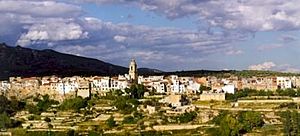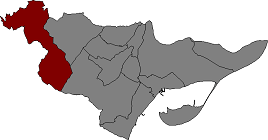La Sénia facts for kids
Quick facts for kids
La Sénia
|
||
|---|---|---|
 |
||
|
||
| Country | ||
| Autonomous Community | ||
| Province | Tarragona | |
| Comarca | Montsià | |
| Area | ||
| • Total | 108.41 km2 (41.86 sq mi) | |
| Elevation | 369 m (1,211 ft) | |
| Population
(2023)
|
||
| • Total | 5,623 | |
| • Density | 51.868/km2 (134.337/sq mi) | |
| Demonym(s) | senienc (catalan), ceniense (spanish) | |
| Postal code |
43560
|
|
La Sénia is a town and municipality in the province of Tarragona, in the autonomous community of Catalonia, Spain. It is part of the Montsià comarca. Throughout the 20th century and up to the present day, La Sénia has been recognized for its prominent furniture industry.
Etymology
The name derives from the Arabic word saniya (flour mill, water wheel), which evolved into the Romance term azenia during the Middle Ages. The town shares its name with the Cenia river, which flows through the municipality.
History
Prehistory
Material remains have been found that demonstrate the presence of inhabitants in prehistoric times. The area of La Sénia has been occupied since ancient times. The caves of dels Rossegadors and de la Tenalla contain Levantine rock art, which are evidence of the seasonal nomadic life of small groups of humans during the Epipaleolithic period. These paintings depict the fauna of the time, hunting human figures, details of male and female clothing, as well as scenes of hunting activities and compositions of unknown meaning.
Ancient regime
The lands of the Cenia river remained under the jurisdiction of the Knights Hospitaller from 1178, under the command of the Ulldecona Castle. It was this order that granted the first charter of settlement to Guillem de Moragues, a native of Tortosa. La Sénia, then known as Cenia, was recognized as a town on 17 April 1232. Later, on 25 January 1235, Guillem de Moragues granted a new charter of settlement to the inhabitants of La Sénia.
During the Catalan Civil War in 1462, La Sénia actively participated against John II of Aragon and was assaulted several times by royal troops until it finally surrendered in June 1466. In 1536, it was incorporated into the commandery of Mirambel.
In 1716, after the War of Spanish Succession, the population lost numerous privileges and local liberties with the implementation of the Nueva Planta decrees of Philip V.
Contemporary era
During the Peninsular War, the town of La Sénia made significant contributions. When it was conquered along with the rest of Montsià and Baix Ebre, it became part of the French department of Bouches-de-l'Èbre. During this period, La Sénia gained importance for its shipbuilding industry. After the expulsion of the French from the region of Montsià, absolutism was restored with the return of Ferdinand VII to the Spanish throne.
When Spain was divided into provinces in 1833, La Sénia became part of Tarragona. In the same year, the First Carlist War began in the area, with the conquest of the town by general Ramón Cabrera, leading to constant sieges by Isabelline troops until 1840 when general Leopoldo O'Donnell defeated Ramón Cabrera.
On 18 April 1871 the Spanish noble title of Marquesado de la Cenia was established by king Amadeo I in favor of Fernando Cotoner y Chacón, who held the ranks of lieutenant general, captain general of Puerto Rico and minister of war. Subsequently, on 15 August 1882, Alfonso XII granted the title the Grandee distinction.
In the early 20th century, in 1907, electricity was installed in the town.
During the early stages of the Spanish Civil War, in 1937, the Spanish Republican Air Force built an air base in the area known as els Plans. Republican aviators initially flew from this airfield, which was later used by German forces. Nationalist troops entered the town on April 14, 1938, after the Aragon Offensive. Afterward, the personnel of the German Condor Legion settled in the airfield, which became their most important operating base. During the summer, the airfield was highly active as the Germans carried out numerous operations in the Levante Offensive and the Battle of the Ebro. On 16 December that year, a group of Republican Tupolev SB bombers conducted a surprise attack on the Condor Legion facilities, destroying seven German Messerschmitt Bf 109 fighters and causing severe damage to the ground installations. It was one of the most audacious attacks by the Republican Air Force during the war.
In the 1980s, a significant change occurred in the official name of the municipality, which had remained unchanged since its founding in 1232. This change involved the translation of the previous and original name Cenia into Catalan, and the municipality has been officially known as La Sénia ever since.
Culture
The parish church is dedicated to Saint Bartholomew and Saint Roque. It was built between the 17th and 18th centuries in a Baroque style with neoclassical details. It has a single nave with side chapels and a square-shaped bell tower. The roof is topped with a dome, and the bell windows are located at the corners. The old town of the village preserves a similar aesthetic, with houses featuring grand portals and balconies. In 1983, a regulation was established to preserve this area of the town. About 6 km (3.7 mi) from the center of La Sénia is the sanctuary of the Virgin of Pallerols, located on the top of Pallerols mountain. It is a simple building that houses an image of the Virgin of Palleróos, the patron saint of the town.
In 1904, the Banda Harmónica de Cenia was founded, composed of 75 musicians. Now known as Agrupació Musical Senienca, it has gained recognition in the neighboring regions and has received awards in international competitions. In 2002, it was awarded the Creu de Sant Jordi, a significant recognition. The main festival of La Sénia is celebrated in August and is known for its horse races. During the month of September, a pilgrimage is made to the sanctuary of Pallerols.
Economy
The economy of La Sénia has traditionally revolved around agriculture, with dryland crops such as olive trees, vineyards, and cereals being prominent. In the 1930s, the first brush factories emerged. In the 1960s, the construction of the Ulldecona Dam attracted immigrant workers and contributed to the industrial growth of the municipality, with the establishment of paper mills, furniture factories, railing companies, freight transportation, and construction.
The olive oil produced in La Sénia, extracted from its ancient olive trees, is marketed as a luxury product and can reach a price of €15 per half liter.
Regarding the furniture industry, small industrial establishments applying industrial processes to furniture manufacturing emerged in the 1940s and 1950s. In the 1960s, companies implementing large-scale manufacturing processes were established. In the 1970s, factories specialized in different stages of the furniture manufacturing and sales process. Today, the wood, furniture, and accessories sector employs the majority of the population. La Sénia has become the main producer of modern furniture in Spain and a reference in the industry in Catalonia. The municipality has the Catalonia Furniture Technology Dissemination Center (AMBIT Living Spaces Cluster) and a wood waste treatment plant. It has recently been recognized as a Center of Artisanal Interest in Catalonia for furniture manufacturing by the Executive Council of Catalonia.
Twin towns
- Cazorla, Andalusia




